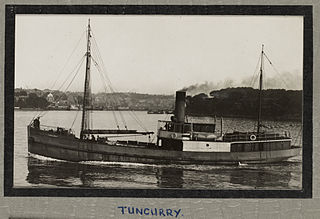
Booti Booti National Park is a national park in New South Wales, Australia, 282 kilometres (175 mi), by road, north-north-east of Sydney. The holiday town of Forster-Tuncurry lies immediately to the north.
Jack Kenneth Loney was an amateur Australian maritime historian who published over one hundred books and numerous newspaper and magazine articles. He was a schoolteacher and principal until his retirement. He became interested in maritime history after preparing several general history booklets covering the Otway region of western Victoria, Australia.

Wendouree was a steel steamship built as a collier by S & H Morton & Co., Leith, Scotland for Huddart Parker & Co. Pty. Ltd. She was later refitted to carry passengers for the Melbourne to Sydney run.
SS Lindus was an Australian iron-hulled coastal cargo ship driven by a 160 H.P. 2-cylinder compound steam engine with a top cruising speed of 10 knots. She was built in 1881 by Edward Withy & Co., Hartlepool, England. Her engines were built by T. Richardson & Sons, Hartlepool. She had a complement of 24 crewmembers.
The Ability was a wooden Steamer coastal transport cargo ship of 140 tons, owned by Parsons, R & Plunkett. She was scuttled and abandoned off Newcastle, New South Wales on 3 June 1960 or off Sydney on 3 April 1965.
The Acme was a wooden top sail schooner that was driven ashore at Seal Rocks, New South Wales while carrying timber from Camden Haven to Sydney under the command of Captain James Henry Jackson on the 15 July 1876. There were no casualties.
Active was a wooden ketch that was wrecked on 19 January 1898 on the Oyster Bank at the entrance of Newcastle Harbour, New South Wales, Australia, near the previously wrecked schooner Colonist while carrying a cargo of ironbark to Morpeth, New South Wales, under the command of Captain P. Williams. There were no casualties but the ship was lost. The wreck has not been located, but the approximate co-ordinates of the shipwreck are 32.92°S 151.79°E.
Ada was a wooden ketch that was wrecked on the Oyster Bank at Newcastle, New South Wales, Australia.
Ada and Ethel was a wooden schooner that was wrecked 10 miles (16 km) southeast of Seal Rocks, New South Wales, Australia, on 26 October 1887.
Adelaide was a wooden cutter used in the cedar trade that was wrecked and lost off the Hawkesbury River in Broken Bay, New South Wales, in July 1837 while carrying a load of cedar. The wreck has not been located, but a vessel of its description was reported capsized between Cabbage Tree Bay and Bird Island at approximately 33.6°S 151.3°E.
Adelaide was a wooden schooner that was lost after leaving Newcastle, New South Wales carrying a load of coal on a voyage to Gisborne, New Zealand in May 1898. There were two deaths.
Admiral Gifford was a wooden schooner that was lost while travelling between Port Macquarie and Sydney, New South Wales, on 8 October 1834 with a cargo of grain, hides and tallow.
The Adolphus was a wooden brigantine that was wrecked on the rocks west of Pier Head at Wollongong harbour in New South Wales on 29 November 1866. The ship was carrying coal from Wollongong to Sydney under the command of Captain William Kean. There were no casualties, but the vessel was lost. The wreck has not been located, but the approximate coordinates are 34.4189°S 150.9071°E.
The Advance was a diesel powered wooden carvel schooner built in 1903 at Kaipara, that was wrecked at Wreck Bay, New South Wales in 1915. The wreck has not been located, but the approximate coordinates are 35.19°S 150.65°E.
Advance was a screw steamer that was wrecked when she sprang a leak whilst carrying tea-tree saplings between Taree, New South Wales and Coopernook. She was lost on the Manning River, New South Wales on 17 June 1933.
The Agnes was a wooden cutter that was wrecked when it run ashore on the New South Wales on 4 July 1865.

The Tuncurry was a wooden carvel screw steamer built in 1903 at Cape Hawke in the Australian state of New South Wales, that was wrecked when she sprang a leak whilst carrying explosives, cement, whiskey, jam and other general cargo between Sydney and Brisbane. She was lost off Barrenjoey Head, Broken Bay, New South Wales on 22 October 1916.

Fitzroy was a steel-hulled steamship built in 1912 at Old Kilpatrick, Scotland in 1912. Thirty-one people were killed when Fitzroy capsized in a gale whilst carrying a general cargo between Coffs Harbour and Sydney off Cape Hawke, New South Wales on 26 June 1921.

The Narara was a wooden carvel screw steamer built in 1900 at Jervis Bay, that was wrecked when it sprang a leak while carrying general cargo between Sydney and the Hawkesbury River and was lost at 2 ml SE off Little Reef Newport near, Barranjoey, New South Wales on 29 May 1909. The vessel commenced her runs from Sydney Harbour to the Hawkesbury River in January 1900 and continued on this run till the time of her final 1909 sinking. During 1903 the vessel was burned to the water line and sank at its mooring only to be refloated and rebuilt and started back on the same run.

SS Colonist was a British iron-hulled coastal cargo ship driven by a 3-cylinder triple expansion steam engine. She was built in 1889 by Osbourne, Graham & Co. Ltd, North Hylton, England. She had a complement of 29 crewmembers.






